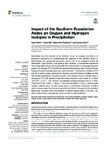Impact of the Southern Ecuadorian Andes on Oxygen and Hydrogen Isotopes in Precipitation
| dc.contributor.author | Gébelin, A | en |
| dc.contributor.author | Witt, C | en |
| dc.contributor.author | Radkiewicz, M | en |
| dc.contributor.author | Mulch, A | en |
| dc.date.accessioned | 2021-06-12T13:54:27Z | |
| dc.date.available | 2021-06-12T13:54:27Z | |
| dc.date.issued | 2021-05-28 | en |
| dc.identifier.issn | 2296-6463 | en |
| dc.identifier.uri | http://hdl.handle.net/10026.1/17248 | |
| dc.description.abstract |
<jats:p>Determining how the elevation of the Northern Andes has evolved over time is of paramount importance for understanding the response of the Northern Andes to deformational and geodynamic processes and its role as an orographic barrier for atmospheric vapor transport over geologic time. However, a fundamental requirement when using stable isotope data for paleoaltimetry reconstructions is knowledge about the present-day changes of δ<jats:sup>18</jats:sup>O and δD with elevation (isotopic lapse rate). This study defines the present-day river isotopic lapse rate near the Equator (∼3°S) based on analysis of δ<jats:sup>18</jats:sup>O and δD of surface waters collected from streams across the Western Cordillera and the Inter-Andean depression in Southern Ecuador. The results for the two domains show a decrease of δ<jats:sup>18</jats:sup>O with elevation which fits a linear regression with a slope of −0.18‰/100 m (R<jats:sup>2</jats:sup> = 0.73, <jats:italic>n</jats:italic> = 83). However, we establish a present-day lapse rate of −0.15‰/100 m for δ<jats:sup>18</jats:sup>O (R<jats:sup>2</jats:sup> = 0.88, <jats:italic>n</jats:italic> = 19) and -1.4‰/100 m for δD (R<jats:sup>2</jats:sup> = 0.93, <jats:italic>n</jats:italic> = 19) from water samples collected along the west facing slopes of the Western Ecuadorian Cordillera which is mainly subject to moisture transport from the Pacific. We argue that this empirical relationship, consistent with those obtained in different tropical areas of the world, can inform stable isotope paleoaltimetry reconstructions in tropical latitudes.</jats:p> | en |
| dc.language.iso | en | en |
| dc.publisher | Frontiers Media | en |
| dc.title | Impact of the Southern Ecuadorian Andes on Oxygen and Hydrogen Isotopes in Precipitation | en |
| dc.type | Journal Article | |
| plymouth.volume | 9 | en |
| plymouth.journal | Frontiers in Earth Science | en |
| dc.identifier.doi | 10.3389/feart.2021.664590 | en |
| plymouth.organisational-group | /Plymouth | |
| plymouth.organisational-group | /Plymouth/Faculty of Science and Engineering | |
| plymouth.organisational-group | /Plymouth/Faculty of Science and Engineering/School of Geography, Earth and Environmental Sciences | |
| plymouth.organisational-group | /Plymouth/REF 2021 Researchers by UoA | |
| plymouth.organisational-group | /Plymouth/REF 2021 Researchers by UoA/UoA07 Earth Systems and Environmental Sciences | |
| dcterms.dateAccepted | 2021-05-05 | en |
| dc.rights.embargodate | 2021-06-15 | en |
| dc.identifier.eissn | 2296-6463 | en |
| dc.rights.embargoperiod | Not known | en |
| rioxxterms.versionofrecord | 10.3389/feart.2021.664590 | en |
| rioxxterms.licenseref.uri | http://www.rioxx.net/licenses/all-rights-reserved | en |
| rioxxterms.licenseref.startdate | 2021-05-28 | en |
| rioxxterms.type | Journal Article/Review | en |


